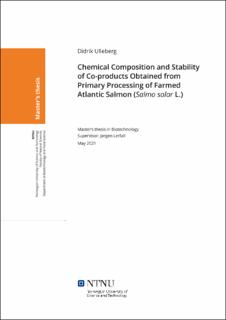| dc.contributor.advisor | Lerfall, Jørgen | |
| dc.contributor.author | Ulleberg, Didrik | |
| dc.date.accessioned | 2021-09-25T16:12:53Z | |
| dc.date.available | 2021-09-25T16:12:53Z | |
| dc.date.issued | 2021 | |
| dc.identifier | no.ntnu:inspera:75551004:5108893 | |
| dc.identifier.uri | https://hdl.handle.net/11250/2782623 | |
| dc.description.abstract | Menneskehetens behov for mat øker samtidig som vi må redusere vårt økologiske fotavtrykk, noe som gjør det viktig å utnytte alle tilgjengelige ressurser. Norsk akvakultur produserer i dag store mengder koprodukter fra Atlantisk laks (Salmo Salar L.) som ikke blir optimalt utnyttet når det blir brukt som dyrefor. Derfor er denne avhandlingens mål å bidra til den økene kunnskapen om koprodukter fra laks som en ingrediens i mat, ved å kartlegge den kjemiske sammensetningen og stabiliteten til råstoffet. Den kjemiske sammensetningen til koproduktene ble studert ved en proksimalt komposisjonsanalyse, mengden vann- og salt-løselige proteiner og fettsyredistribusjonen. Den kjemiske stabiliteten ble undersøkt ved analyse av generell proteaseaktivitet, syretall og ATP nedbrytning. Koproduktene som studeres er buklist, skrapekjøtt og avskjær fra Atlantisk oppdrettslaks av både Superior- og Produksjonskvalitet. Resultatene oppnådd i denne avhandlingen viser hvordan buklisten har et høyere fettinnhold og lavere proteininnhold enn fileten, mens det motsatte gjelder for manuelt produsert skrapekjøtt. Avskjæret har en varierende sammensetning avhengig av hvordan det er produsert. Fordelingen av spesifikke fettsyrer var lik i alle koproduktene og i fileten. Det demonstreres at ATP raskere brytes ned i koprodukter som er rike på fett, som buklist og avskjær, sammenliknet med det magrere skrapekjøttet og fileten. Buklisten viser også tegn på å ha høyre nivåer av generell proteaseaktivitet sammenliknet med de andre fraksjonene. Et viktig funn er at koprodukter fra Produksjonslaks har like god kjemisk komposisjon og stabilitet som koprodukter fra Superiorlaks. Undersøkelsene gjort i løpet av dette prosjektet viser at manuelt produserte koprodukter fra Superior- og Produksjonskvalitet laks inneholder verdifulle næringsstoffer velegnet til matproduksjon. Resultatene viser også hvordan de forskjellige koproduktene har ulike funksjonelle egenskaper som det må bli tatt hensyn til, slik som det økte fettinnholdet i buklist. Videre arbeid må bli gjort for å produsere koprodukter fra laks av en jevn og høy kvalitet i industriell skala, og for å utvikle produkter akseptert av markedet. | |
| dc.description.abstract | The increasing demand for food combined with the need to reduce humankind’s environmental footprint makes it crucial to use all available raw materials. The Norwegian aquaculture industry produces large quantities of co-products from Atlantic salmon (Salmo salar L.) that are underutilised when used as animal feed. Therefore, the present thesis aims to contribute to the growing knowledge of salmon co-products as ingredients in foods by studying the chemical composition and stability of the residual raw material. The chemical composition was studied by determining the co-products proximate composition, the amount of water- and salt-soluble protein and distribution of fatty acids. Meanwhile, the chemical stability was studied through analysis of the general proteolytic activity, acid value and ATP degradation. The co-products within the scope of this thesis are the belly flap, deboned meat, and Bits & Pieces from farmed Atlantic salmon of Superior and Production quality. The results obtained in the present thesis demonstrate that belly flaps have a higher lipid content and a lower protein content than the filet, while the opposite was true for the manually deboned meat fraction. The Bits & Pieces showed a varying proximate composition depending on how it was produced. All investigated co-products had a similar distribution of specific fatty acids as the filet. Furthermore, the fatty belly flap and Bits & Pieces were more susceptible to ATP degradation than the leaner deboned meat and filet. The findings also suggest that the belly flap might have increased levels of general proteolytic activity. Importantly, it was demonstrated that co-products from Superior and Production quality salmon have similar chemical composition and stability. The preliminary results suggest that manually produced co-products from both Superior and Production quality salmon contain valuable nutrients suited as ingredients in food production. Moreover, the results indicate different functional properties of the fractions that must be accounted for, such as the increased fat content in belly flaps. Further efforts must be made to produce salmon co-products of consistent and high quality at an industrial scale and to develop food products accepted by the market. | |
| dc.language | eng | |
| dc.publisher | NTNU | |
| dc.title | Chemical Composition and Stability of Co-products Obtained from Primary Processing of Farmed Atlantic Salmon (Salmo salar L.) | |
| dc.type | Master thesis | |
